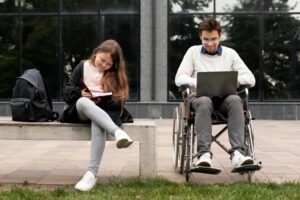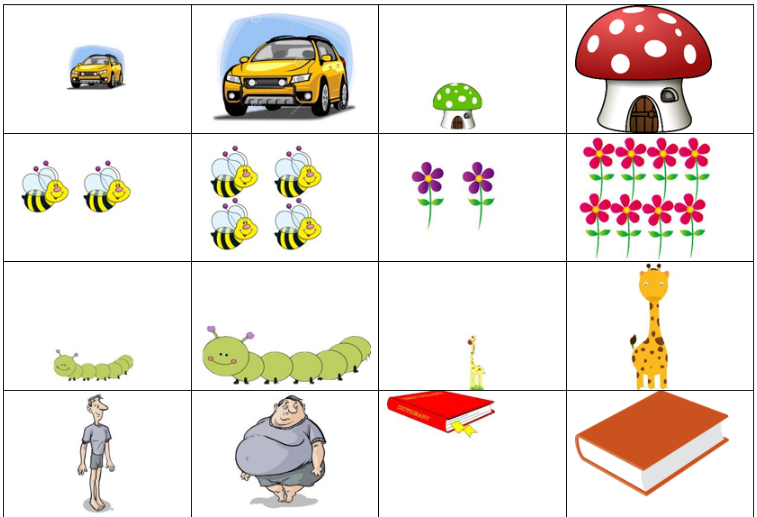New ways of inclusive digital teaching
Materials
1. Introduction
In today’s rapidly evolving educational landscape, inclusive digital teaching is becoming increasingly vital. Schools and educational leaders must embrace new technologies to ensure that all students, including those with special educational needs, have access to quality education. This micro-learning unit explores various innovative digital teaching methods, including mobile learning, virtual reality (VR), augmented reality (AR), and artificial intelligence (AI), from a leadership and school perspective.
Mobile education applications have gained significant popularity in parallel with the rapid evolution of mobile technology. The development process of educational software is influenced by the dynamic progress of mobile technology. In this context, there is a potential to support face-to-face education through the integration of technological tools. Additionally, the widespread use of mobile devices such as smartphones and tablets for educational purposes today has created a need for the development of effective software and tools for students (Achmadi et al. 2012).
Especially for students with special educational needs, the necessity of benefiting from computer-assisted tools holds great importance. In this context, the usability and significance of developed software are highlighted through an example of a mobile education application focused on the education of students with special needs (Karanfiller, Göksu & Yurtkan, 2017).
2. Mobile Learning
Mobile learning leverages the ubiquity of smartphones and tablets to provide flexible and accessible educational opportunities. It supports personalized learning experiences, enabling students to learn at their own pace and in their preferred environment(Golitsyna & Polovnikova, 2011).
Key Points:
- Mobile learning applications can support students with intellectual disabilities by providing interactive and engaging content.
- These applications can be used for teaching basic concepts such as quantity, width, length, and size.
- Mobile devices enable learning anytime and anywhere, fostering independence among students.
Table: Advantages of Mobile Learning

3. Virtual Reality (VR) and Augmented Reality (AR)
VR and AR technologies create immersive learning experiences that can significantly enhance student engagement and understanding. These technologies offer unique opportunities to visualize complex concepts and create interactive learning environments(Shaukat, 2023).
Key Points:
- VR can simulate real-world scenarios, providing students with hands-on learning experiences.
- AR overlays digital information on the real world, helping students better understand abstract concepts.
- Both VR and AR can be particularly beneficial for students with special needs by providing multisensory learning experiences.
VR in Education:
- Simulates real-life experiences.
- Enhances student engagement.
- Provides safe environments for practical learning.
AR in Education:
- Augments real-world information.
- Facilitates interactive learning.
- Supports visual and kinesthetic learners.
Table: Example of AI Applications in Education

4. Artificial Intelligence (AI)
AI in education involves the use of machine learning algorithms to personalize learning experiences and provide real-time feedback. AI-powered tools can adapt to the individual needs of students, making learning more efficient and effective(Alam, 2021 ).
Key Points:
- AI can analyze student performance and customize content to address specific learning gaps.
- AI tutors can provide instant feedback and support, enhancing the learning process.
- AI tools can help teachers by automating administrative tasks, allowing them to focus more on instruction.
5. Example Studies
The rise of mobile technological devices has led to significant changes in the field of education since the early 2000s. Smart boards, smartphones, and other digital devices are commonly used as technological tools supporting educational materials. Mobile devices and personal computers have provided opportunities for the development of applications on different operating systems and platforms by educational software developers. This has attracted the attention of researchers in the field of educational software development, making mobile education software development a significant focal point parallel to advancements in mobile technology.
As an example of studies in this field, in 2004, Bulun and his team conducted a study on the use of mobile devices in education. This study explored the advantages of mobile devices in supporting education. Additionally, (Traxler, 2009) developed a learning method supporting mobile learning using handheld computers, smartphones, and wireless technology.
As examples of studies targeting various student groups, in 2012, Lopez and his team designed and released a supportive iOS application for students with intellectual disabilities. Furthermore, in 2014, Christinaki and colleagues developed an educational game to teach emotional skills that could be used in the diagnosis of autism.
Another study focusing on mobile education applications in special education is the evaluation of a program for training students with autism spectrum disorder conducted by Ahmad and his team in 2012. In this study, advanced processes were carried out on an iPod-based speech-generating device, and the effects of the program were assessed.
Some research conducted in Turkey has shown that mobile education applications can be effectively used in education. A study conducted by Kuzu and his team in 2013 revealed positive opinions about software developed for parents of individuals with intellectual disabilities.
7. Conclusion
Leadership in schools plays a crucial role in implementing and supporting new ways of inclusive digital teaching. By embracing technologies like mobile learning, VR, AR, and AI, schools can create more engaging, personalized, and effective learning environments for all students, particularly those with special educational needs. Continuous professional development for educators is essential to stay updated with these advancements and effectively integrate them into teaching practices.
Mobile education applications provide a flexible learning environment that can adapt to the learning speeds and styles of students. Students can progress at their own pace, focus on individualized content, and personalize their learning processes (Korucu & Alkan, 2011)). These features can respond more appropriately to the special education needs of students with intellectual disabilities.
The interactive and game-based learning features of these applications can offer students the opportunity to learn in a fun environment. Gamification methods can increase motivation and encourage students to participate more actively. This is particularly important in capturing the attention of students with intellectual disabilities and making the learning process more engaging.
However, it is essential to consider some limitations associated with the use of mobile education applications. Inequalities in technology access may limit students’ access to these applications. Additionally, teachers may need appropriate training and continuous support to effectively use these applications(Woodwill, 2011).
In conclusion, the use of mobile education applications in the education of students with intellectual disabilities has the potential to offer learning experiences tailored to individual needs. However, collaboration and education among teachers, students, and technology providers are crucial for the effective integration of these applications.
References
Achmadi, D. Kagohara, D. Vandermeer, L. Oreilly, M. F. Lancioni, G. E. Sutherland, D. & Sigafoos, J. (2012). Teaching Advanced Operation Of An Ipod-Based Speech-Generating Device To Two Students With Autism Spectrum Disorders. Research in Autism Spectrum Disorders, 6(4), 1258-1264
Alam, A. (2021, November). Possibilities and apprehensions in the landscape of artificial intelligence in education. In 2021 International Conference on Computational Intelligence and Computing Applications (ICCICA) (pp. 1-8). IEEE.
Christinaki, E. Vidakis, N. & Triantafyllidis, G. (2014). A Novel Educational Game For Teaching Emotion İdentification Skills To Preschoolers With Autism Diagnosis. Computer Science and Information Systems, 11(2), 723-743.
Golitsyna, I. N., & Polovnikova, N. L. (2011). Mobile learning as a new technology in education. Educational technologies and society, 1(3), 40-46.
Karanfiller, T. Göksu, H. & Yurtkan, K. (2017). Özel Eğitim Gereksinimi Olan Öğrenciler için Temel Kavram Öğretimi Mobil Uygulama Tasarımı. Eğitim ve Bilim, 42(192).
Korucu, A. T. & Alkan, A. (2011). Differences Between M-Learning (Mobile Learning) And E-Learning, Basic Terminology And Usage Of M-Learning In Education. Procedia-Social and Behavioral Sciences, 15, 1925-1930.
Traxler, J. (2009). Current State Of Mobile Learning. Mobile learning: Transforming The Delivery Of Education And Training, 1, 9-24.
Shaukat, S. M. (2023). Exploring the potential of augmented reality (AR) and virtual reality (VR) in education. International Journal of Advanced Research in Science, Communication and Technology, 3(2), 51-56.
Woodwill, G. (2011). The Beginnings of Mobile Learning. The Mobile Learning Edge, 9-12.
1. Leadership/ School’s perspective
Inclusive by Design: Advancing Digital Literacy for All
10 min
By the end of this e-learning material, participants will be able to;
- Understand the role of leadership in inclusive digital teaching.
- Explore new technologies in inclusive digital education.
- Identify strategies for implementing inclusive digital tools in schools.
Inclusive Digital Education, Digital Literacy, Assistive Technologies








Funded by the European Union. Views and opinions expressed are however those of the author(s) only and do not necessarily reflect those of the European Union or the European Education and Culture Executive Agency (EACEA). Neither the European Union nor EACEA can be held responsible for them (2022- 1 -SI01 -KA220-HED-000088368).







